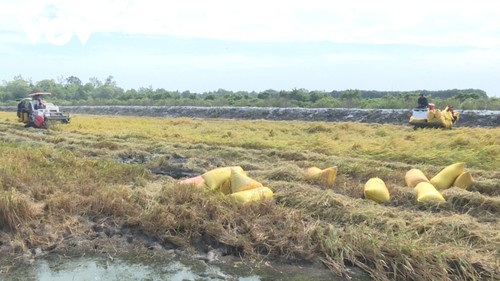 Bac Lieu province has 40,000 ha of cultivation land under the rice-shrimp farming model. (Photo: VOV) Bac Lieu province has 40,000 ha of cultivation land under the rice-shrimp farming model. (Photo: VOV)
|
Rice-shrimp farming is a model that protects the environment, has little risk, and is suitable for a majority of farmers.
Raising shrimp makes the soil more fertile, makes rice grow better, and cuts the cost of fertilizers and pesticides. After each shrimp crop, the organic humus, microorganisms, and leftover shrimp food are a good source of nutrients for the rice plants. After each rice crop, the soil is improved, creating an environment in which shrimp grow faster and are less susceptible to diseases.
Visiting the countryside around Gia Rai town these days, you’ll see green rice fields, many of which are already in full bloom.
Doan Thanh Tung, a farmer in Phong Thanh A commune, said that since he adopted the rice-shrimp model on his 3 hectares, his income has increased significantly.
“The model is much more profitable than in the past. I can grow rice and improve the soil. My shrimp crop is also efficient and successful. My annual profit from shrimp is between 12,300 USD and 16,400 USD. Every year is profitable,” said Tung.
 The rice-shrimp farming model proves efficient and adaptive to climate change in Bac Lieu province. (Photo: VOV) The rice-shrimp farming model proves efficient and adaptive to climate change in Bac Lieu province. (Photo: VOV)
|
Gia Rai town has more than 30,000 hectares under cultivation in two ecological zones – saline water and fresh water.
The 23,000 hectares of saline water used to specialize in shrimp farming but was not efficient. In 2020, farmers switched to the rice-shrimp model, combining raising giant prawns and goby fish with growing rice. The initial 3,000 hectares for the rice-shrimp farming model in the first years has now increased to 7,000 hectares.
Huynh Thanh Toan, head of the Economic Section of Gia Rai town, said that the first years of raising shrimp were effective. But later, efficiency gradually decreased.
“So the local administration encouraged farmers to grow a rice crop on the shrimp land. This model increases soil fertility, so shrimp farming is more effective. Farmers make an average profit of 4,100 USD a year per hectare of rice and shrimp,” said Toan.
To improve the efficiency of the model, Bac Lieu province has invested in building irrigation systems and closed dikes to regulate water and salinity and store freshwater.
Phong Thanh A commune in Gia Rai town has built a dike to support irrigation of 3,000 hectares under the rice-shrimp model.
Nguyen Anh Thu, a farmer in Phong Thanh A commune, said, “A few years ago, saltwater intrusion affected my rice fields. Since the dike and sluice were built, we can store more fresh water.”
Thanks to the new model, people's lives have changed. The number of poor or near-poor households has reduced from 400 to 47. The average per capita income now stands at 3,000 USD per year.
Pham Van Het, Secretary of Phong Thanh A commune’s Party Committee, said that people are very excited because the combined rice-shrimp model is highly efficient.
“Their economic conditions have greatly improved over the past 2 years. They don't have to go far to do business anymore,” Het said.
Bac Lieu province has 40,000 hectares of land under the rice-shrimp production model. By 2025 that will grow to 43,000 hectares.